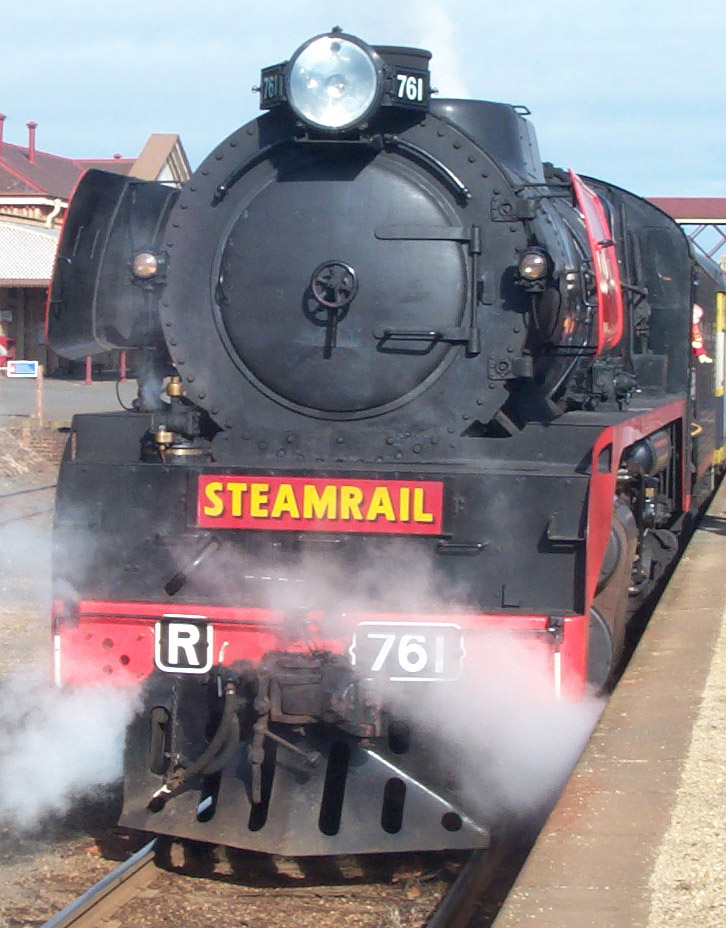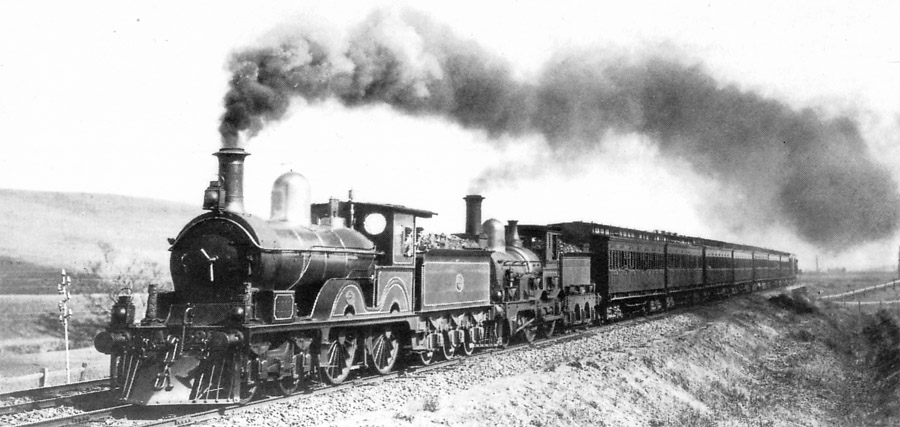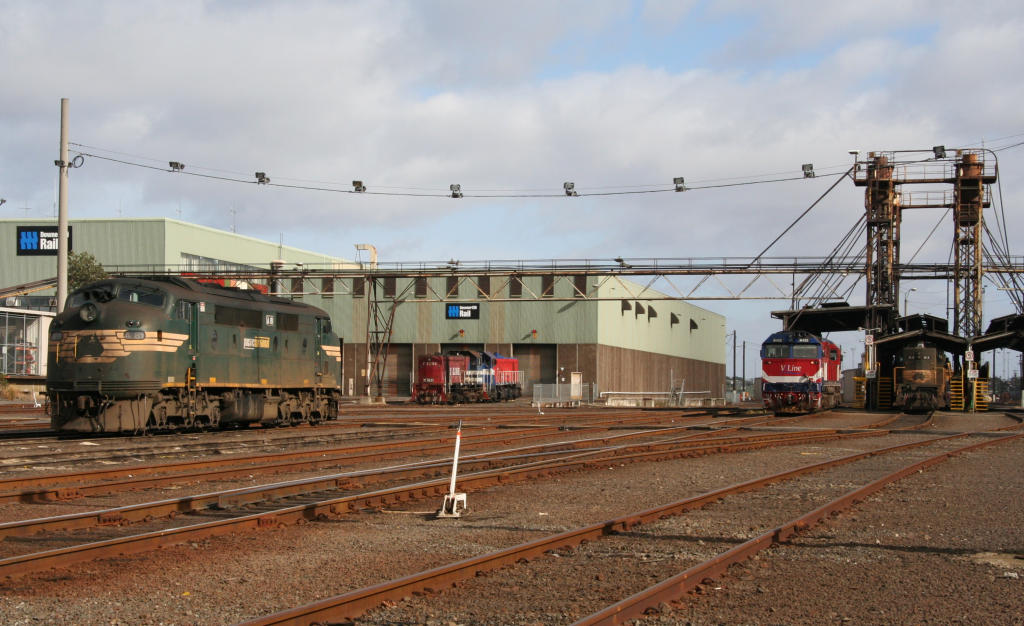|
North Melbourne Locomotive Depot
North Melbourne Locomotive Depot was the main location for maintenance of the Victorian Railways steam locomotive fleet based in Melbourne. Located in the middle of the Melbourne Yard precinct in the suburb West Melbourne near North Melbourne station, the site is now occupied by the Melbourne Steel Terminal. The depot was described by railway employees as ''"the hub of the universe"'', ''"the VR's nearest approach to Dante's Inferno"'', or ''"the Black Hole of Calcutta"'' depending on their disposition. History The depot was opened sometime in the 1880s by the Victorian Railways, replacing its first locomotive depot located in the Spencer Street station yard. It was located beside the Railway Canal, a section of Moonee Ponds Creek that enabled the direct unloading of coal transported by sea from New South Wales. The rectangular building was built of brick and iron with three turntables located inside. There were six track entrances, two at the front from the main goods yard, th ... [...More Info...] [...Related Items...] OR: [Wikipedia] [Google] [Baidu] |
West Melbourne, Victoria
West Melbourne is an inner-city suburb in Melbourne, Victoria, Australia, north-west of the Melbourne central business district, located within the City of Melbourne local government area. West Melbourne recorded a population of 8,025 at the . Located adjacent to the CBD, West Melbourne is bounded by Victoria Street and the Sunbury/Werribee railway lines in the north, Footscray Road, the Moonee Ponds Creek; and by La Trobe Street in the south. Peel Street and the Flagstaff Gardens help form the eastern boundary, with the western boundary defined by the Maribyrnong River and Coode Island. Being originally largely an industrial area, a significant portion of West Melbourne is occupied by the Port of Melbourne, the Dynon Railway Yards and the Melbourne Markets. These include the Wholesale Fruit and Vegetable and Fish Markets, as well as the National Flower Centre. It also contains an increasing number of residential and commercial properties, consisting of a mixture of Victori ... [...More Info...] [...Related Items...] OR: [Wikipedia] [Google] [Baidu] |
Dieselisation
Dieselisation (US: dieselization) is the process of equipping vehicles with a diesel engine or diesel engines. It can involve replacing an internal combustion engine powered by petrol (gasoline) fuel with an engine powered by diesel fuel, as occurred on a large scale with trucks, buses, farm tractors, and building construction machinery after the Second World War. Alternatively it can involve replacing the entire plant or vehicle with one that is diesel-powered; the term commonly describes the generational replacement between the 1930s and the 1970s of railway steam locomotives with diesel locomotives, and associated facilities. Water transport The Two-stroke diesel engine for marine applications was introduced in 1908 and remains in use today. It is the most efficient prime mover to date, models such as the Wärtsilä-Sulzer RTA96-C offer a thermal efficiency of 50% and over 100,000 horsepowers. First steps towards conversions using diesel engines as means of propulsion (on sm ... [...More Info...] [...Related Items...] OR: [Wikipedia] [Google] [Baidu] |
1880s Establishments In Australia
Year 188 (CLXXXVIII) was a leap year starting on Monday of the Julian calendar. At the time, it was known in the Roman Empire as the Year of the Consulship of Fuscianus and Silanus (or, less frequently, year 941 ''Ab urbe condita''). The denomination 188 for this year has been used since the early medieval period, when the Anno Domini calendar era became the prevalent method in Europe for naming years. Events By place Roman Empire * Publius Helvius Pertinax becomes pro-consul of Africa from 188 to 189. Japan * Queen Himiko (or Shingi Waō) begins her reign in Japan (until 248). Births * April 4 – Caracalla (or Antoninus), Roman emperor (d. 217) * Lu Ji (or Gongji), Chinese official and politician (d. 219) * Sun Shao, Chinese general of the Eastern Wu state (d. 241) Deaths * March 17 – Julian, pope and patriarch of Alexandria * Fa Zhen (or Gaoqing), Chinese scholar (b. AD 100) * Lucius Antistius Burrus, Roman politician (executed) * Ma Xiang, Chines ... [...More Info...] [...Related Items...] OR: [Wikipedia] [Google] [Baidu] |
Demolished Buildings And Structures In Melbourne
Demolition (also known as razing, cartage, and wrecking) is the science and engineering in safely and efficiently tearing down of buildings and other artificial structures. Demolition contrasts with deconstruction, which involves taking a building apart while carefully preserving valuable elements for reuse purposes. For small buildings, such as houses, that are only two or three stories high, demolition is a rather simple process. The building is pulled down either manually or mechanically using large hydraulic equipment: elevated work platforms, cranes, excavators or bulldozers. Larger buildings may require the use of a wrecking ball, a heavy weight on a cable that is swung by a crane into the side of the buildings. Wrecking balls are especially effective against masonry, but are less easily controlled and often less efficient than other methods. Newer methods may use rotational hydraulic shears and silenced rock-breakers attached to excavators to cut or break through wo ... [...More Info...] [...Related Items...] OR: [Wikipedia] [Google] [Baidu] |
History Of Rail Transport In Australia
:''This article is part of the history of rail transport by country series Australians generally assumed in the 1850s that railways would be built by the private sector. Private companies built railways in the then colonies of Victoria, opened in 1854, and New South Wales, where the company was taken over by the government before completion in 1855, due to bankruptcy. South Australia's railways were government owned from the beginning, including a horse-drawn line opened in 1854 and a steam-powered line opened in 1856. In Victoria, the private railways were soon found not to be financially viable, and existing rail networks and their expansion were taken over by the colony. Government ownership also enabled railways to be built to promote development, even if not apparently viable in strictly financial terms. The railway systems spread from the colonial capitals, except in cases where geography dictated a choice of an alternate port. Railways in Australia date from the 10 ... [...More Info...] [...Related Items...] OR: [Wikipedia] [Google] [Baidu] |
Railway Workshops In Victoria (Australia)
Rail transport (also known as train transport) is a means of transport that transfers passengers and goods on wheeled vehicles running on rails, which are incorporated in tracks. In contrast to road transport, where the vehicles run on a prepared flat surface, rail vehicles (rolling stock) are directionally guided by the tracks on which they run. Tracks usually consist of steel rails, installed on sleepers (ties) set in ballast, on which the rolling stock, usually fitted with metal wheels, moves. Other variations are also possible, such as "slab track", in which the rails are fastened to a concrete foundation resting on a prepared subsurface. Rolling stock in a rail transport system generally encounters lower frictional resistance than rubber-tyred road vehicles, so passenger and freight cars (carriages and wagons) can be coupled into longer trains. The operation is carried out by a railway company, providing transport between train stations or freight customer facili ... [...More Info...] [...Related Items...] OR: [Wikipedia] [Google] [Baidu] |
Buildings And Structures Demolished In 1965
A building, or edifice, is an enclosed structure with a roof and walls standing more or less permanently in one place, such as a house or factory (although there's also portable buildings). Buildings come in a variety of sizes, shapes, and functions, and have been adapted throughout history for a wide number of factors, from building materials available, to weather conditions, land prices, ground conditions, specific uses, prestige, and aesthetic reasons. To better understand the term ''building'' compare the list of nonbuilding structures. Buildings serve several societal needs – primarily as shelter from weather, security, living space, privacy, to store belongings, and to comfortably live and work. A building as a shelter represents a physical division of the human habitat (a place of comfort and safety) and the ''outside'' (a place that at times may be harsh and harmful). Ever since the first cave paintings, buildings have also become objects or canvasses of much artistic ... [...More Info...] [...Related Items...] OR: [Wikipedia] [Google] [Baidu] |
Victorian Railways K Class
The K class was a branch line steam locomotive that ran on Victorian Railways in Australia from 1922 to 1979. Although its design was entirely conventional and its specifications unremarkable, the K class was in practice a remarkably versatile and dependable locomotive. It went on to outlast every other class of steam locomotive in regular service on the VR, and no fewer than 21 examples of the 53 originally built have survived into preservation. History The K class was the first design from the VR Locomotive Design Section under the stewardship of Alfred E Smith as Chief Mechanical Engineer. The Locomotive Design Section had introduced successful mainline and branchline passenger locomotives with the A2 class and Dd class 4-6-0s, and had recently improved mainline goods services with the C class 2-8-0. They now turned their attention to a requirement for a more powerful branchline goods locomotive, and in 1922 produced a lighter 2-8-0 "Consolidation" locomotive with a a ... [...More Info...] [...Related Items...] OR: [Wikipedia] [Google] [Baidu] |
Geelong Railway Station
Geelong railway station is located on the Warrnambool railway line, Warrnambool line in Victoria (Australia), Victoria, Australia. It serves the city of Geelong, and it opened on 1 November 1856.Geelong Vicsig Together with Ballarat railway station, Ballarat, it is one of only two stations in Victoria to have a 19th-century train shed, and is listed on the Victorian Heritage Register. The railway station complex has also been listed by the National Trust of Australia, as being of state-level significance. History Geelong station was built as the terminus of the Geelong and Melbourne Railway Company line. It was a dead-end terminus, located on the site of the present law courts complex. In November 1876, the railway was extended south to Winchelsea railway station, Victoria, Winchelsea,[...More Info...] [...Related Items...] OR: [Wikipedia] [Google] [Baidu] |
Victorian Railways R Class
The R class was an express passenger steam locomotive that ran on Australia's Victorian Railways (VR) from 1951 to 1974. A long overdue replacement for the 1907-era A2 class 4-6-0, their development and construction was repeatedly delayed due to financial constraints caused by the Great Depression and later the manpower and materials shortages of World War II and the immediate postwar period. Orders eventually totalling 70 locomotives were placed with the North British Locomotive Company of Glasgow. Once initial teething problems were overcome, R class locomotives proved to be a success and their power and speed enabled faster timetabled services. However, they were almost immediately superseded by mainline diesel-electric and electric locomotives on the Victorian Railways from 1952 onwards. With successive orders of diesel-electric locomotives through the 1950s and 1960s gradually displacing them, all but seven of the class were withdrawn and cut up for scrap. Four of the rema ... [...More Info...] [...Related Items...] OR: [Wikipedia] [Google] [Baidu] |
North East Standard Gauge Line, Victoria
The North East railway line is a railway line in Victoria, Australia. The line runs from Albury railway station in the border settlement of Albury–Wodonga to Southern Cross railway station on the western edge of the Melbourne central business district, serving the cities of Wangaratta and Seymour, and smaller towns in northeastern Victoria. The line is owned by VicTrack, but leased to, and maintained by, the Australian Rail Track Corporation, and forms part of the Sydney–Melbourne rail corridor. Unlike most other heavy rail lines in Victoria, the line is completely standard gauge, after works were carried out between 2008 and 2010. However, the broad gauge Tocumwal line runs parallel to the line between Seymour and Broadmeadows. History The Melbourne and Essendon Railway Company opened the first section of the Albury line, from North Melbourne to Essendon, in 1860. Following its takeover by the Victorian Government in 1867, the line was extended by 1872 to S ... [...More Info...] [...Related Items...] OR: [Wikipedia] [Google] [Baidu] |
South Dynon Locomotive Depot
South Dynon Locomotive Depot is an Australian locomotive depot in Melbourne, purpose built for the servicing of diesel and electric locomotives by the Victorian Railways opening in July 1961. It was built adjacent to the Dynon marshalling yards. It has two separate turntables for stabling broad and standard gauge locomotives. It was included in the sale of V/Line Freight to Freight Victoria in May 1999, however has remained a VicTrack Asset, and the lease passed to Pacific National Pacific National is one of Australia's largest rail freight businesses. History In February 2002, National Rail Corporation, National Rail's freight operations and rollingstock (owned by the Government of Australia, Federal, Government of New ... upon its acquisition of Freight Australia in August 2004. Downer EDi Rail operated roads 5 to 11 of the facility as part of a Victorian Locomotive fleet maintenance contract with Pacific National (PN) which ran from September 2008 until June 2016. Th ... [...More Info...] [...Related Items...] OR: [Wikipedia] [Google] [Baidu] |








